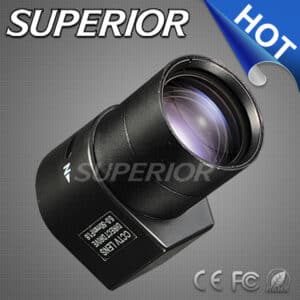Surveillance camera lens are slowly beginning to evolve with the technology that supports them. Before the digital age, a good majority of the surveillance cameras required that a lens be purchased for each camera. Currently, some cameras work this way, but a vast majority have the lens built into the camera. They are sometimes called “board lenses.”

Surveillance Camera Lens
The three main types of digital cameras are classified by their shape: the box, the bullet, and the dome. Bullet and dome cameras have a built-in lens. The board lens is also known as the bullet or dome camera. A lens is almost always required for the box camera.
There are two types of security camera lenses: fixed and varifocal. The name of fixed lenses is accurate; they are immobile and remain in the same position. Varifocals can change their focal length manually or remotely, depending on the lens.
The focal length of a fixed lens cannot be changed, so the captured image’s width will never change. It is ideal for situations where changing focal lengths is not necessary, such as when monitoring a parking area, an exit or entrance, or other applications where the camera is not moved much and zooming is not needed.
Varifocal lenses, on the other hand can be moved in and out to change the focal length. This feature is especially useful when the camera field of view needs to be changed to accommodate moving objects or tight shots. The focal length is usually expressed in millimeters. A fixed camera lens that has a focal distance of 3.0mm produces a wide angle image, while a focal range of 15.5mm produces a narrow-angle shot.
A varifocal is a lens that can be made to have a focal distance as small as you want and any focal range between the maximum focal length. Some of these lenses are manually operated while others have motors that drive the lens.
While we are talking about surveillance camera lenses we will also discuss some other characteristics that you should know in addition to focal length. Four more points come to my mind: F stop; 3. F-stop; 3. Mounting options include CS, C or CS; 4. Iris Auto or Manual.
Depth of Field
The depth of focus is the distance between the camera and the object that remains in focus. In general, the higher F stops and the tighter Iris positions are, the more in-focus objects there will be. A large Depth of Field allows almost all the objects to be in focus. A small Depth of Field, on the other hand will only let a small part of the Field of View be in focus.
F Stop
The F Stop is equal to the foacl distance divided by the effective diameter of the aperture. The F Stop can be described in a simpler way as an indicator of the speed of a lens. The F Stop is used to determine how much light will be absorbed by the lens as it passes through. A lens with a low F Stop is highly efficient, while a lens with a high F Stop will need a lot more light.
Mount CS or C
The “CS” mount is the standard lens mount for surveillance cameras. It differs from the “C” in that the CCD or CMOS (Complementary metal oxide semiconductor) are located at a different distance. The distance between the C and CS mounts is 12.5mm, while 17.5mm is for the C mount.
Iris
The iris controls the amount of light that enters the camera through the sensor. It is best to use an automatic lens for cameras that are mounted in areas with changing light sources. Manual iris is sufficient for cameras that are used indoors or in environments with a constant light source.
Related Posts
Four Types of Barcode Scanners
How useful was this post? Click on a star to rate it! Submit Rating As you found this post useful......
LWIR Imaging (Long-Wave Infrared Imaging) Becomes More Accessible
How useful was this post? Click on a star to rate it! Submit Rating As you found this post useful......




